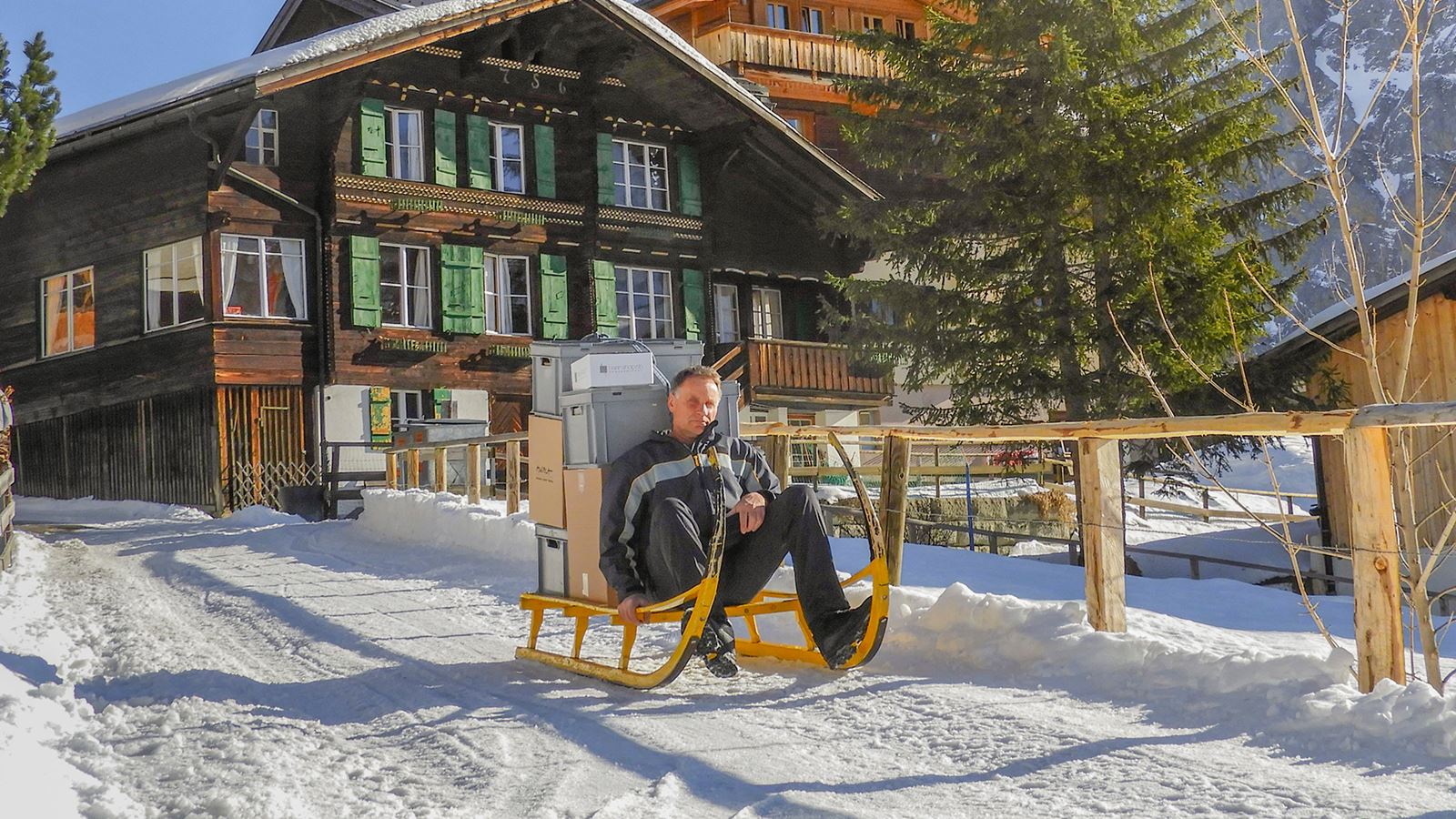Background, People
A winter fairy tale on a mail delivery sledge
In the winter, Hans von Allmen uses a horned sledge to bring people their mail. What looks more like something from a fairy tale to foreign tourists is in fact the best way of reaching remote houses in the winter season.
Rich Content Section

“Is that really how he delivers the mail?”, ask two perplexed tourists in English when Hans von Allmen zips past them on his sledge. No sooner are these words uttered have they faded away again. The snow muffles the sound. The air is cold and dry. Whilst tourists feel like they’re in a Swiss winter wonderland, Hans has little time to give it any thought. For him, this isn’t some spectacle for tourists, it’s his daily routine.
Hans is the mail carrier for Mürren and Gimmelwald. Both these Bernese Oberland resorts are car-free, but that doesn’t mean mail is only delivered by sledge. Mürren is situated on a sunny terrace high above the Lauterbrunnen valley at 1,650 metres above sea level. Gimmelwald is situated 300 meters lower down. “Early in the morning I deliver the mail in Mürren by electric car,” Hans explains. “After that, I take the mail down to Gimmelwald. This is just easier to do by sledge in the winter.”
A winter fairy tale and hard work
When Hans leaves the post office in Mürren, the boxes are piled up on his horned sledge. Once they are tied down, he heads off through the village with the day’s mail. His heavy load in tow, he overtakes tourists waiting at the cable car station. Some of them are so exhausted already from carrying their skis they see Hans as a welcome invitation to take a breather Without knowing it, he helps create the picture-postcard image of a pristine mountain landscape for spellbound onlookers in much the same way the gondoliers of Venice make for perfect holiday snaps. Hans, however, doesn’t have any time for fairy tales. He literally has a huge pile of work waiting for him.

February is peak season in this resort. In Mürren alone, the 380 residents see around 70,000 overnight stays every winter – many of those in holiday homes. “People forward their mail here, and the locals also like placing orders online. It’s just much more practical because we’re a bit remote here,” explains Hans. Exactly what he means by that becomes clear when you reach the sun terrace. Both locations can only be reached by cable car. The journey to the next largest town, Interlaken, takes about an hour by public transport.
Over 30 years experience
Hans doesn’t just have a lot of work, he also has a lot of routine. His many years of experience help him steer his “Horu” horned sledge around tight corners. He knows with pinpoint accuracy when to put his foot on the ground to brake, and knows every obstacle like the back of his hand. He’s been delivering mail in the area for over 30 years. He knows his sledge route as well as a bobsleigh pilot knows his ice track – the only difference being the ride here is more leisurely. Some of the holiday spirit may rub off onto his work, but safety remains the top priority.
Home for Hans
Meanwhile, the midday sun has started to beat down. Hans takes off his coat and rides through the snow in a T-shirt. He passes chalets that are so stunning they make the hearts of Instagrammers race. All the walking also warms Hans up. “Some places are up to ten minutes away from the main road,” Hans explains. He doesn’t know how many metres in altitude he climbs every day.


It’s just what he’s used to. He’s roamed this area ever since he was little. He grew up in Gimmelwald. This is his home. He also goes past his own home on his round, but there’s no time to pop in for a break. “The cable car up to Mürren leaves in two minutes,” he says without even looking at his watch. It’s almost as if he can tell the time by the position of the sun on the horizon of the 4,000-metre peaks around him.

The most normal thing in the world – or maybe not?
The Mürren to Gimmelwald run as a whole takes about two hours. He then pushes his sleigh into the cable car with a friendly good morning to the driver – they know each other, after all. How would he sum up his round today? “These days there isn’t as much snow. Last year, I could barely make it to some of the houses,” he explains, as if a mail carrier fighting through the snow with his horn sleigh were the most normal thing in the world. Which it is – at least for Hans. It’s his daily routine. And if he were to encounter those same tourists at the start of his round again, he could reply: “Yes. That really is how I deliver the mail.”










Copyright: Stefan Kern